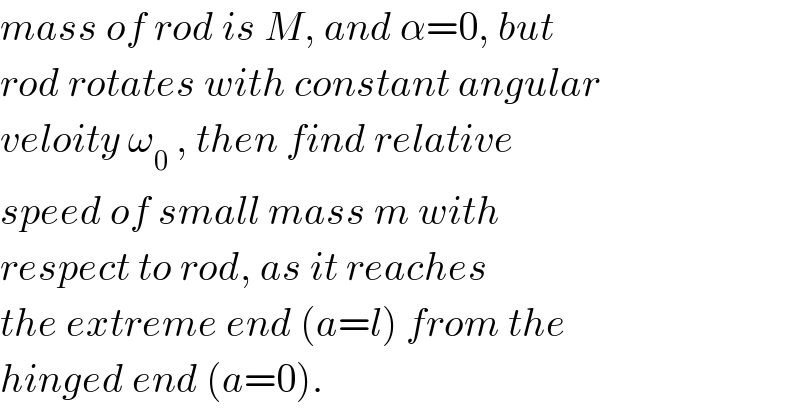
Question and Answers Forum
Question Number 90819 by ajfour last updated on 26/Apr/20

Commented by ajfour last updated on 26/Apr/20

Commented by ajfour last updated on 26/Apr/20

Answered by ajfour last updated on 26/Apr/20

Answered by mr W last updated on 26/Apr/20
![when sleeve is at position x: angular speed of rod =ω speed of sleeve along rod=u acc. of sleeve along rod=a=u(du/dx) Iω_0 =(I+mx^2 )ω ⇒ω=(((Ml^2 )/3)/(((Ml^2 )/3)+mx^2 ))ω_0 =((Ml^2 )/(Ml^2 +3mx^2 ))ω_0 ma−mω^2 x=0 ⇒u(du/dx)−ω^2 x=0 ⇒u(du/dx)−(((Ml^2 ω_0 )/(Ml^2 +3mx^2 )))^2 x=0 ⇒∫_0 ^u_(max) udu=∫_0 ^l (((Ml^2 ω_0 )/(Ml^2 +3mx^2 )))^2 xdx ⇒(u_(mac) ^2 /2)=(((Ml^2 ω_0 )/(3m)))^2 ∫_0 ^l ((xdx)/((((Ml^2 )/(3m))+x^2 )^2 )) ⇒u_(max) ^2 =(((Ml^2 ω_0 )/(3m)))^2 ∫_0 ^l ((d(((Ml^2 )/(3m))+x^2 ))/((((Ml^2 )/(3m))+x^2 )^2 )) ⇒u_(max) ^2 =(((Ml^2 ω_0 )/(3m)))^2 [(1/(((Ml^2 )/(3m))+x^2 ))]_l ^0 ⇒u_(max) ^2 =(((Mlω_0 )/(3m)))^2 [(1/(M/(3m)))−(1/((M/(3m))+1))] ⇒u_(max) ^2 =(((Mlω_0 )/(3m)))^2 [(1/((M/(3m))((M/(3m))+1)))] ⇒u_(max) =lω_0 (√(M/(M+3m)))](Q90901.png)
Commented by ajfour last updated on 26/Apr/20

